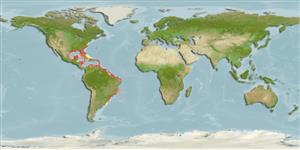Common names from other countries
Classification / Names / Names
Κοινά ονόματα | Συνώνυμα | Catalog of Fishes (gen., sp.) | ITIS | CoL | WoRMS
Environment: milieu / climate zone / depth range / distribution range
Οικολογία
; εύρος βάθους 1 - 130 m (Ref. 96392). Tropical
Western Atlantic: Caribbean Sea to southern Brazil. Tropical to subtropical.
Length at first maturity / Μέγεθος / Βάρος / Age
Maturity: Lm ? range ? - ? cm
Feeds primarily on gastropods, bivalves and small crustaceans, and sometimes on amphipods, isopods, crabs, smaller echinoderms and fish larvae (Ref. 96392).
Life cycle and mating behavior
Γεννητική Ωρίμανση | Αναπαραγωγή | Γεννοβολία | Αβγά | Γονιμότητα | Προνύμφες
Members of the class Asteroidea exhibit both asexual (regeneration and clonal) and sexual (gonochoric) means of reproduction. Life cycle: Embryos hatch into planktonic larvae and later metamorphose into pentamorous juveniles which develop into young sea stars with stubby arms.
Alvarado, J.J. and J. Cortés. 2009. (Ref. 83942)
IUCN Red List Status (Ref. 130435)
CITES status (Ref. 108899)
Not Evaluated
Not Evaluated
Threat to humans
Harmless
Human uses
| FishSource |
Εργαλεία
Περισσότερες πληροφορίες
Κοινά ονόματαΣυνώνυμαΘηρευτέςΑναπαραγωγήΓεννητική ΩρίμανσηΓεννοβολίαΓονιμότηταΑβγάEgg development
Age/SizeΑύξησηLength-weightLength-lengthΜορφολογίαΠρονύμφεςΑφθονία
Διαδικτυακές πηγές
Estimates based on models
Preferred temperature
(Ref.
115969): 21.4 - 27.7, mean 24.7 (based on 498 cells).
